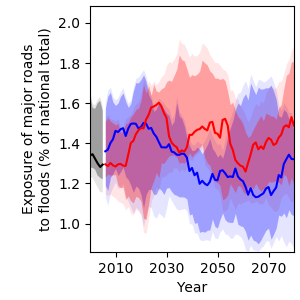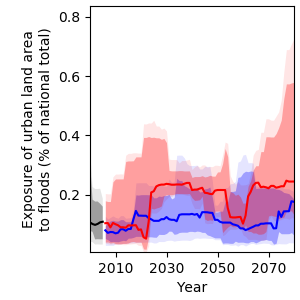Tanzania: Infrastructure
Climate change is expected to significantly affect Tanzania’s infrastructure sector through extreme weather events. High precipitation amounts can lead to flooding of transport infrastructure, especially in the coastal areas, while high temperatures can cause roads, bridges and protective structures to develop cracks and degrade more quickly. This will require earlier replacement and lead to higher maintenance and replacement costs. Tanzania’s transport sector is dominated by road transport, which accounts for 80 % of passenger traffic and 95 % of freight traffic [24]. Transport infrastructure is very vulnerable to extreme weather events, yet essential for social, economic and agricultural livelihoods. Roads serve communities to trade goods and access healthcare, education, credit as well as other services, especially in rural and remote areas. Overall, Tanzania has one of the lowest paved-road densities in Africa, relying on few major roads [24]. Thus, investments will have to be made to build climate-resilient road networks.
Extreme weather events will also have devastating effects on human settlements and economic production sites, especially in urban areas with high population densities such as Dar es Salaam or Mwanza. Informal settlements are particularly vulnerable to extreme weather events: Makeshift homes are often built in unstable geographical locations including riverbanks and coastal areas, where flooding can lead to loss of housing, contamination of water, injury or death. Dwellers usually have low adaptive capacity to respond to such events due to high levels of poverty and lack of risk-reducing infrastructures. The flooding-poverty nexus is particularly strong in Dar es Salaam, where many households experience floods on an annual basis and even during average precipitation events [25]. In April 2018, 11 976 people in Dar es Salaam have been affected by a flood event [26]. 42 houses and 21 latrines collapsed, and 342 houses were severely damaged. Flooding and droughts will also affect hydropower generation: Tanzania is planning to increase its hydropower capacity from 0.5 gigawatts in 2015 to a planned volume of 3.4 gigawatts in 2030. However, variability in precipitation and climatic conditions could severely affect river levels and disrupt hydropower generation [27].
Despite the risk of infrastructure damage being likely to increase, precise predictions of the specific location and extent of exposure are difficult to make. For example, projections of river flooding are subject to substantial modelling uncertainty, largely due to the uncertainty of future projections of precipitation amounts and their spatial distribution, affecting flood occurrence (see also Figure 5). In Tanzania, projections show no change in the exposure of major roads to river floods under RCP2.6 and a slight increase under RCP6.0 (Figure 13). In 2000, 1.3 % of major roads were exposed to river floods at least once a year, while by 2080, this value is projected to slightly increase to 1.5 % under RCP6.0. In a similar way, exposure of urban land area to river floods is projected to increase only under RCP6.0, from 0.11 % in 2000 to 0.24 % in 2080 (Figure 14).


The exposure of the GDP to heatwaves is projected to increase from around 2 % in 2000 to 6 % (RCP2.6) and 16 % (RCP6.0) by the end of the century (Figure 15). It is recommended that policy makers start identifying heat-sensitive economic production sites and activities, and integrating climate adaptation strategies such as improved solar-powered cooling systems, “cool roof” isolation materials or switching the operating hours from day to night [28].

References
[24] United Republic of Tanzania Vice President’s Office, “National Climate Change Strategy,” Dodoma, Tanzania, 2012.
[25] T. Sakijege, J. Lupala, and S. Sheuya, “Flooding, Flood Risks and Coping Strategies in Urban Informal Residential Areas: The Case of Keko Machungwa, Dar Es Salaam, Tanzania,” Jamba J. Disaster Risk Stud., vol. 4, no. 1, pp. 1–10, 2012.
[26] IFRC, “Emergency Plan of Action Final Report: Tanzania Floods,” Geneva, Switzerland, 2019.
[27] D. Conway, P. Curran, and K. E. Gannon, “Policy Brief: Climate Risks to Hydropower Supply in Eastern and Southern Africa,” London and Leeds, UK, 2018.
[28] M. Dabaieh, O. Wanas, M. A. Hegazy, and E. Johansson, “Reducing Cooling Demands in a Hot Dry Climate: A Simulation Study for Non-Insulated Passive Cool Roof Thermal Performance in Residential Buildings,” Energy Build., vol. 89, pp. 142–152, 2015.


